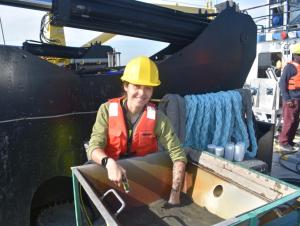

written by Olesia Makhutova (Kormilets) and Susan Daniel
In September, another Cooperative Science and Monitoring Initiative (CSMI) survey took place in Lake Ontario. A team of scientists from the Great Lakes Center boarded the research vessel Lake Guardian in the Port of Rochester. The R/V Lake Guardian is owned and operated by the U.S. EPA and is used for all major surveys on the Great Lakes. The vessel is outfitted with advanced scientific equipment like the rosette water sampler and well-equipped laboratories that collect some of the best data in the region. Prior to departure and the official start of the survey, GLC scientists Alexander Karatayev, Lyubov Burlakova, Olesia Makhutova (Kormilets), and Lillian Denecke were given a safety briefing, at the end of which they were required to don red immersion suits and looked like astronauts. The immersion suits are very difficult to put on and move in, but greatly increase the chance of survival at sea. Thankfully, these suits never had to come in handy while sailing aboard R/V Lake Guardian!
Lasting only a week, the entire survey was the shortest CSMI survey ever completed by the GLC scientists. During the cruise, samples were taken from 71 locations by an international team of scientists. The R/V Lake Guardian runs non-stop, 24-7, and can be very exhausting for those onboard; luckily, meals are prepared by a cook! While some samples were processed directly on the ship, most of the samples were transported back to Buffalo for further analysis. The primary study of this year was monitoring the state of the benthic fauna, or organisms that live in the sediment of the lake; specifically, how quagga mussels (Dreissena rostriformis bugensis) have changed the environment over the past 5 years. In addition to traditional methods of sampling, a relatively new method of video recording of the sediment surface was used in Lake Ontario. This nearly real time approach successfully revealed that there may be a decrease in the abundance of quagga mussels, especially at depths of less than 50 meters. However, this result will be verified with traditional methods.
Other research questions were addressed during this CSMI survey. GLC Research Scientist, Olesia Makhutova (Kormilets) initiated a study using fatty acid analysis to describe the diet of quagga mussels living at different depths. Fatty acid analysis can reflect the average trophic level of organisms in the food web and provide clues as to what an organism is eating on a regular basis. Samples of quagga mussels were taken from different depth zones and will be analyzed at the Buffalo State University laboratories. A separate team of scientists from National Oceanic and Atmospheric Administration, Paul Glyshaw and Rachel Orzechoswki, studied morphological changes in quagga mussels along depth and food gradients. Interestingly, quagga mussels are morphologically different at different depths: shallow-water quagga mussels are colored, large, and more voluminous with a thick shell, while deep-water quagga mussels are white, small, and flat with a thinner shell. Another question explored during the CSMI survey by Robin Richardson-Coy, a graduate student of Yvonne Vadeboncoeur at Wright State University, was related to food quality and trophic interactions. Robin collected algae from the surfaces of quagga mussel shells and from various substrates to determine the taxonomic composition and their nutritional quality for consumers. Soon they will be able to figure out which algae are a more valuable food for the lake’s consumers.
Lastly, and the most challenging, were sediment core samples collected by Canadian scientists Maria Dittrich, Khoren Avetisyan, and Zach Diloreto. Sediment cores were used to measure oxygen and other chemicals in different layers of the sediment. These samples can be very difficult to collect from hard substrate like rocks, gravel, and sand. However, results from this project will help us to better understand how quagga mussels change the sediment-water interface, and thus the ecosystem at a chemical level for other creatures.
During the entire week, professional photographer Yola Monakhov Stockton (formerly Buffalo State faculty, currently at University of Hawaii) “captured” our work on the ship. Yola’s “samples” were not only moments that could be captured in photographs, but also in movements and sounds of our work. She tried to capture all the most interesting moments of the cruise and, it seems to me, she succeeded. Perhaps soon we will have the opportunity to watch a film about the survey and see everything that happens there from a completely different perspective.
Image caption: Lillian Denecke ellutriating a benthic sample on the R/V Lake Guardian.
Some content on this page is saved in PDF format. To view these files, download Adobe Acrobat Reader free. If you are having trouble reading a document, request an accessible copy of the PDF or Word Document.
